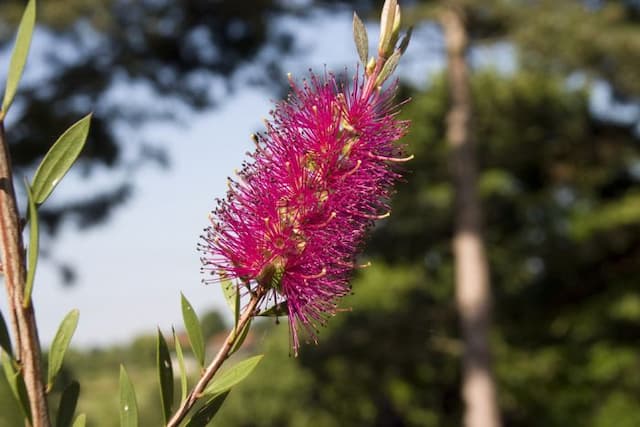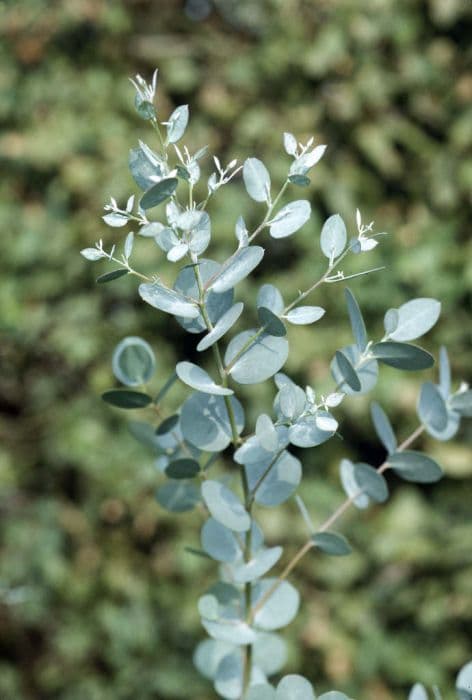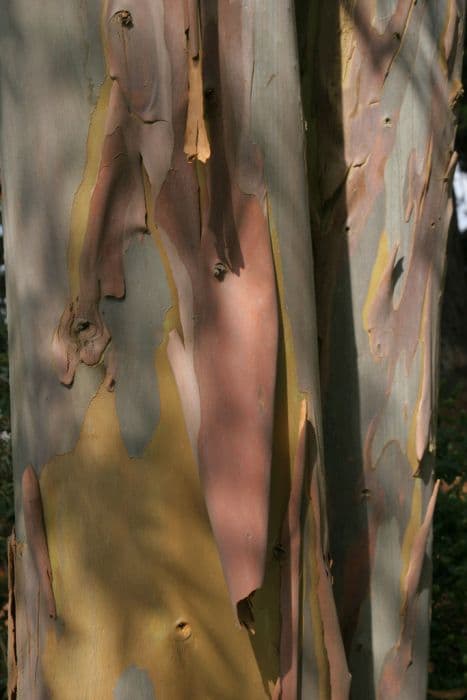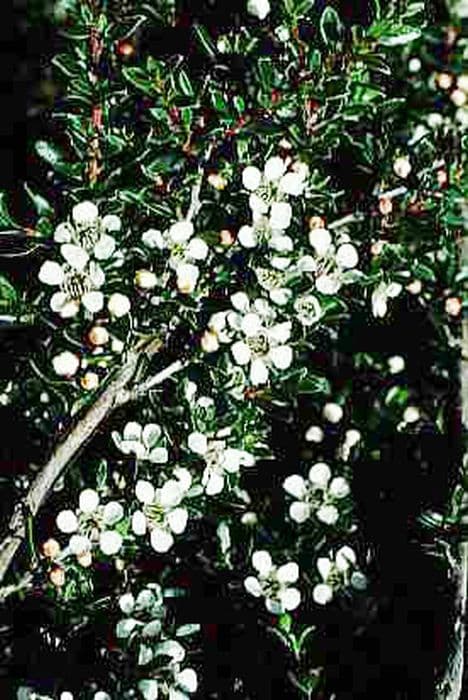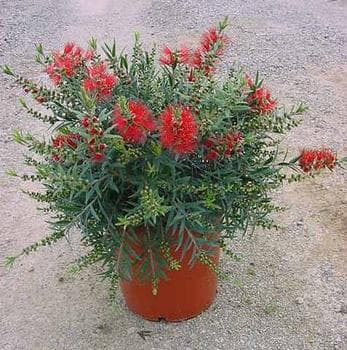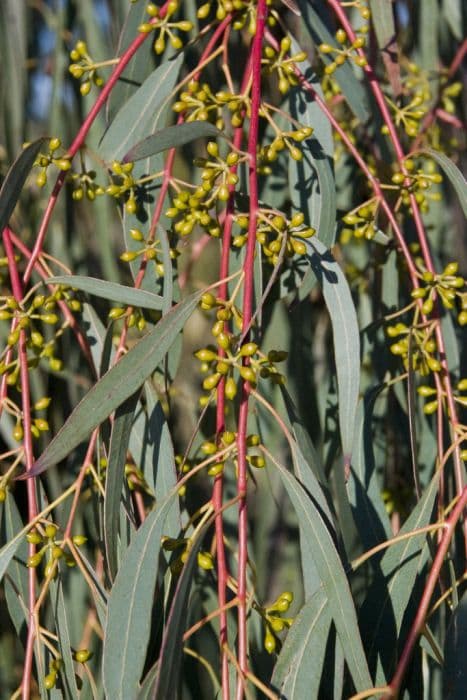Weeping Bottlebrush Callistemon viminalis 'Captain Cook'

ABOUT
The 'Captain Cook' is a beautiful flowering plant renowned for its unique and eye-catching appearance. It is characterized by its abundance of bright red, bottle brush-like flowers that resemble the shape of a cylindrical brush used to clean bottles. These iconic blooms are made up of numerous individual flowers, each contributing to the dense, brush-like structure. The vivid red inflorescences often contrast strikingly against the plant's foliage. The leaves of the 'Captain Cook' are lance-shaped and exhibit a pleasant, soft green color that complements the vivid red of the flowers. The foliage is arranged in a manner that can be either opposite each other along the branches or variable in arrangement which adds to the plant's lush and somewhat weeping texture. As a cultivar, the 'Captain Cook' is appreciated for its ornamental value in gardens and landscapes. Although we are avoiding details about its size, it is compact in nature making it a favored choice for various garden settings. The plant can bloom several times a year, with the flowering season generally peaking in the spring and early summer. This seasonal display brings a burst of color and visual interest that can enhance the aesthetic of any planting area. Overall, the 'Captain Cook' makes for a strikingly ornamental addition to gardens, with its noteworthy red flowers and graceful foliage creating a spectacle of color and form. Its manageable nature and vibrant flowers ensure that it remains a popular choice among garden enthusiasts looking for a touch of drama and a hint of the exotic.
About this plant
 Names
NamesFamily
Myrtaceae.
Synonyms
Weeping Bottlebrush, Captain Cook Bottlebrush, Red Cascade.
Common names
Callistemon viminalis, Melaleuca viminalis.
 Toxicity
ToxicityTo humans
Bottlebrush, the common name for Callistemon viminalis 'Captain Cook', is not known to be toxic to humans. However, as with any plant, it is always possible that some individuals may experience allergic reactions or mild gastrointestinal discomfort if parts of the plant are ingested. If these or any other symptoms occur, it is advisable to seek medical attention.
To pets
Bottlebrush, the common name for Callistemon viminalis 'Captain Cook', is not recognized as a toxic plant to pets such as cats and dogs. General recommendations suggest that pets should not eat plants as they may cause digestive upset or an allergic reaction in some animals. If a pet exhibits symptoms such as vomiting, diarrhea, or unusual behavior after consuming the plant, it is important to consult a veterinarian.
 Characteristics
CharacteristicsLife cycle
Perennials
Foliage type
Evergreen
Color of leaves
Green
Flower color
Red
Height
6 feet (1.83 meters)
Spread
4 feet (1.22 meters)
Plant type
Shrub
Hardiness zones
9
Native area
Australia
Benefits
 General Benefits
General Benefits- Landscape Aesthetics: Callistemon viminalis 'Captain Cook', commonly known as Bottlebrush 'Captain Cook', adds vibrant color and unique texture to gardens with its stunning red flower spikes.
- Wildlife Attraction: The plant's flowers are rich in nectar, attracting birds, especially honeyeaters, and beneficial insects like bees to the garden for pollination.
- Low Maintenance: Bottlebrush 'Captain Cook' requires minimal care once established, making it a convenient choice for gardeners of all skill levels.
- Drought Resistance: This plant is highly drought-tolerant, making it suitable for xeriscaping and arid climate landscaping.
- Soil Adaptability: It can adapt to a variety of soil types, although it prefers well-draining soil.
- Pest and Disease Resistance: Bottlebrush 'Captain Cook' is relatively resistant to many common pests and diseases, reducing the necessity for chemical treatments.
- Frost Tolerance: The plant can withstand mild frosts, making it suitable for temperate regions.
 Medical Properties
Medical PropertiesThis plant is not used for medical purposes.
 Air-purifying Qualities
Air-purifying QualitiesThis plant is not specifically known for air purifying qualities.
 Other Uses
Other Uses- Bottlebrush 'Captain Cook' plants can be used as a natural dye source. The flowers, when boiled, can create a yellow to green dye suitable for fabric coloring.
- The fibrous wood of Bottlebrush can be processed to craft lightweight objects such as small carvings or even as a base for model making.
- These plants can serve as noise buffers when planted in dense hedges alongside busy roads or highways.
- When kept pruned and dense, Bottlebrush 'Captain Cook' can be shaped into living sculptures or topiaries in formal gardens.
- The distinctive flower spikes can be included in dried flower arrangements, maintaining their shape and color for extended periods.
- Due to its dense growth habit, the Bottlebrush can be used to stabilize soil and prevent erosion on slopes or banks.
- In larger landscapes, Bottlebrush can be utilized as a windbreak to protect more delicate plants or outdoor living areas.
- The vibrant blooms can be used to add a natural touch to water features as they will float and provide a splash of color.
- Bird enthusiasts may plant Bottlebrush 'Captain Cook' to attract and provide a natural food source for nectar-feeding birds.
- This plant's unique brush-like flowers can be a teaching tool in botanical studies to showcase the diversity of flower structures.
Interesting Facts
 Feng Shui
Feng ShuiThe Bottlebrush is not used in Feng Shui practice.
 Zodiac Sign Compitability
Zodiac Sign CompitabilityThe Bottlebrush is not used in astrology practice.
 Plant Symbolism
Plant Symbolism- Resilience: Bottlebrush, including the Callistemon viminalis 'Captain Cook', is known for its hardiness and ability to withstand tough conditions, symbolizing the capacity to endure and thrive through challenges.
- Protection: The bottlebrush flower's dense brush-like appearance can symbolize a strong barrier or a protective shield, suggesting safeguarding and defense.
- Healing: Historically, various parts of the bottlebrush plant have been used for medicinal purposes, leading to a symbolism of healing and the alleviation of pain.
- Renewal: As the bottlebrush blooms with vibrant red flowers, it is often seen as a sign of new beginnings and rejuvenation, symbolizing freshness and the start of new phases in life.
 Water
WaterThe Weeping Bottlebrush, or Callistemon viminalis 'Captain Cook', prefers consistent moisture but does not like to be waterlogged. It should be watered deeply once or twice a week, depending on the weather conditions, allowing the soil to dry slightly between waterings. During hotter, drier periods, increase the frequency to maintain soil moisture. Each watering session should provide enough water to soak the root zone; for potted plants, this might be around 1-2 gallons depending on the size of the pot, ensuring that excess water can drain freely.
 Light
LightThe Weeping Bottlebrush thrives best in full sun, which means it should receive at least six hours of direct sunlight daily. An ideal spot for it would be in a south-facing garden or landscape where it can enjoy uninterrupted sunlight exposure. Partial shade is tolerable, but flowering may not be as prolific in these conditions.
 Temperature
TemperatureWeeping Bottlebrush is hardy and can withstand a range of temperatures, typically surviving in conditions as low as 20°F and as high as over 100°F. However, they prefer a temperate climate with temperatures consistently between 50°F and 90°F. Frost may damage new growth, so protection or placement in warmer spots may be necessary in cooler climates.
 Pruning
PruningPruning the Weeping Bottlebrush is important to maintain its shape and to encourage bushier growth with more flowers. Prune lightly in late winter or early spring, cutting back last year's growth by about a third, and shape as desired. Deadheading, or the removal of spent flowers, can be done throughout the blooming season to promote continuous flowering.
 Cleaning
CleaningAs needed
 Soil
SoilBottlebrush 'Captain Cook' prefers a well-drained soil mix with a slightly acidic to neutral pH around 6.0 to 7.0. A mix of loam, sand, and peat or compost is ideal to ensure proper drainage while retaining enough moisture for the roots. Regular garden soil can be amended with organic material such as compost to improve texture and fertility.
 Repotting
RepottingBottlebrush 'Captain Cook' should be repotted every 2-3 years or when root-bound. Younger plants may require more frequent repotting. Upgrade to a slightly larger pot each time to allow for continued growth without causing undue stress on the plant.
 Humidity & Misting
Humidity & MistingBottlebrush 'Captain Cook' prefers moderate to high humidity levels. Maintaining humidity around 50-60% is suitable for healthy growth. In drier climates, regular misting or a humidity tray can be beneficial in maintaining these levels.
 Suitable locations
Suitable locationsIndoor
Place in bright light, away from draft, water when topsoil is dry.
Outdoor
Full sun, well-drained soil, protect from severe frost.
Hardiness zone
9-11 USDA
 Life cycle
Life cycleCallistemon viminalis 'Captain Cook', commonly known as Captain Cook Bottlebrush, begins its life cycle when the seed germinates, usually in spring or early summer. Following germination, the seedling stage is characterized by initial leaf growth as the plant establishes its root system. As it matures into the vegetative stage, it produces long, slender leaves and begins to form woody stems, during which it undergoes substantial growth. The plant reaches the flowering stage, producing its distinctive red bottlebrush-shaped flowers, which attract pollinators and subsequently lead to seed formation. After pollination, the plant develops woody seed capsules that release seeds when mature, completing the reproductive cycle. Captain Cook Bottlebrush is a perennial plant, and it can go through the flowering and seed-setting stages multiple times throughout its lifespan, which can last several years.
 Propogation
PropogationPropogation time
Spring-Early Summer
The most popular method of propagating Callistemon viminalis 'Captain Cook', commonly known as Weeping Bottlebrush, is through semi-hardwood cuttings. This process typically takes place during late summer to early fall when the plant's growth has begun to mature and harden slightly. To propagate, take cuttings of about 4 to 6 inches (10 to 15 centimeters) in length from the current year’s growth, ensuring each cutting has several leaf nodes. The leaves on the lower half of the cutting should be removed, and the cut end can be dipped in a rooting hormone to encourage root development. Then, the cutting is placed in a well-draining soil mixture, with the lower half submerged. The soil should be kept moist, but not waterlogged, and the cuttings should be placed in a warm area with indirect sunlight. Roots typically develop within a few weeks, after which the new plants can be gradually acclimated to outdoor conditions and eventually transplanted into the garden.
